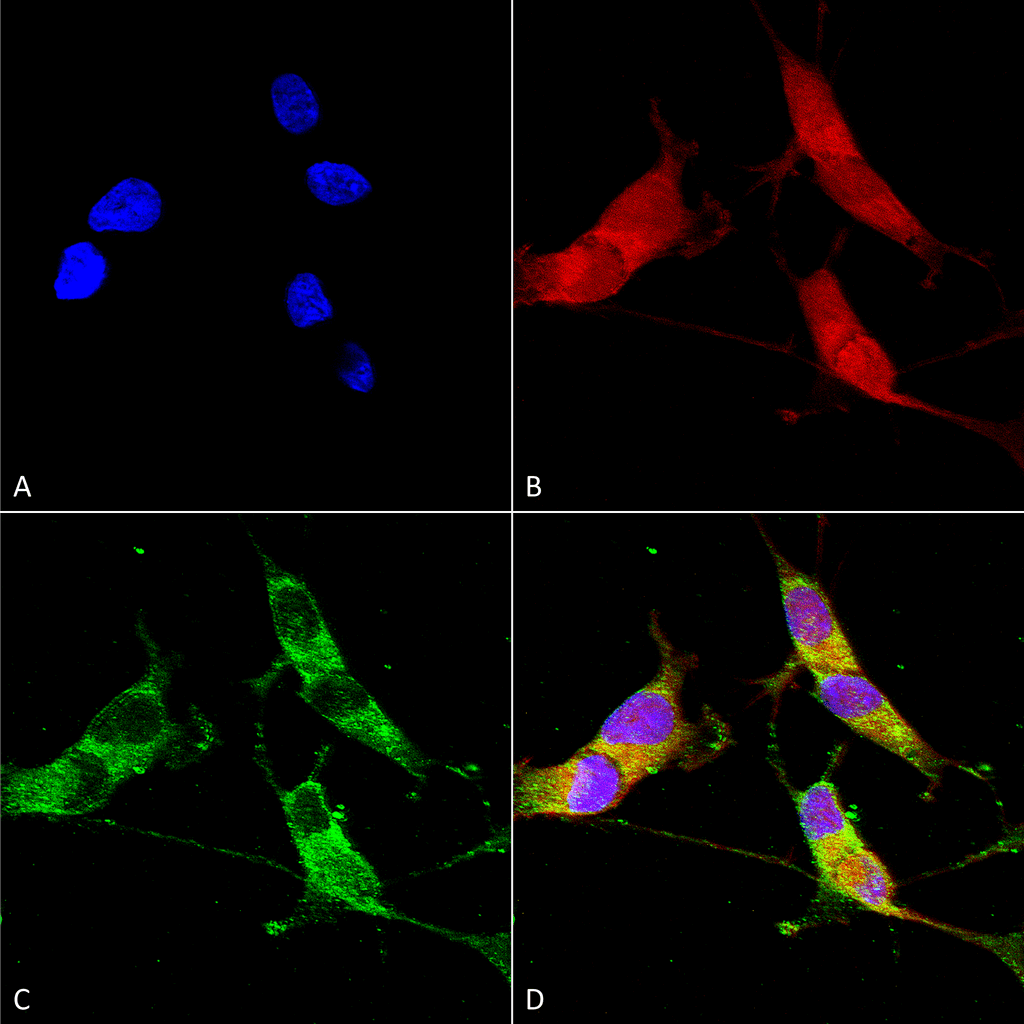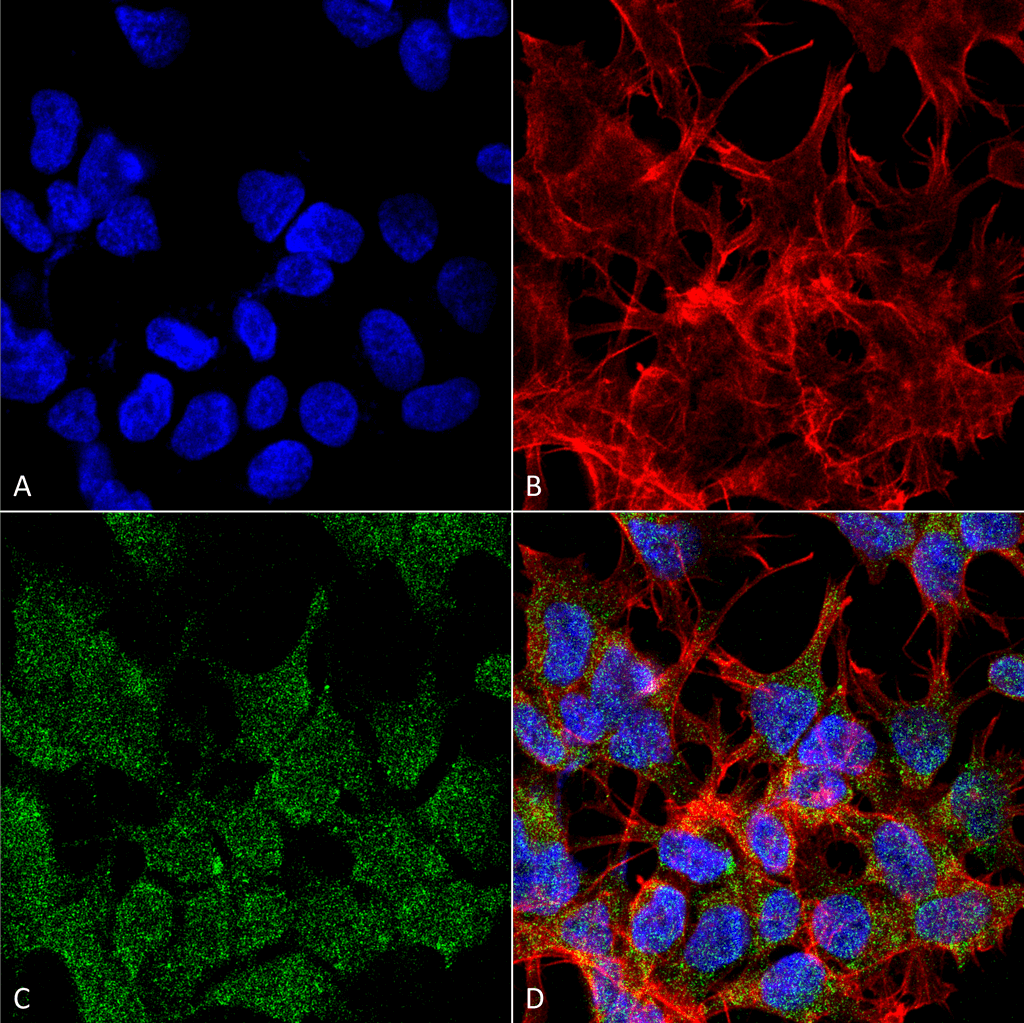Anti-VGlut2 Transporter Antibody (56515)
Anti-VGlut2 Transporter Antibody (56515)
Product No.: 56515
- -
- -
Clone S29-29 Target VGlut2 Transporter Formats AvailableView All Product Type Monoclonal Alternate Names VGluT2, Differentiation-associated BNPI, Differentiation-associated Na(+-dependent inorganic phosphate cotransporter, Solute carrier family 17 member 6 Isotype Mouse IgG1 Applications ICC , IF , IHC , WB |
Data
 Immunocytochemistry/Immunofluorescence analysis using Mouse Anti-VGLUT2 Monoclonal Antibody, Clone S29-29 (56515). Tissue: Neuroblastoma cells (SH-SY5Y). Species: Human. Fixation: 4% PFA for 15 min. Primary Antibody: Mouse Anti-VGLUT2 Monoclonal Antibody (56515) at 1:50 for overnight at 4°C with slow rocking. Secondary Antibody: AlexaFluor 488 at 1:1000 for 1 hour at RT. Counterstain: Phalloidin-iFluor 647 (red) F-Actin stain; Hoechst (blue) nuclear stain at 1:800, 1.6mM for 20 min at RT. (A) Hoechst (blue) nuclear stain. (B) Phalloidin-iFluor 647 (red) F-Actin stain. (C) VGLUT2 Antibody (D) Composite.
Immunocytochemistry/Immunofluorescence analysis using Mouse Anti-VGLUT2 Monoclonal Antibody, Clone S29-29 (56515). Tissue: Neuroblastoma cells (SH-SY5Y). Species: Human. Fixation: 4% PFA for 15 min. Primary Antibody: Mouse Anti-VGLUT2 Monoclonal Antibody (56515) at 1:50 for overnight at 4°C with slow rocking. Secondary Antibody: AlexaFluor 488 at 1:1000 for 1 hour at RT. Counterstain: Phalloidin-iFluor 647 (red) F-Actin stain; Hoechst (blue) nuclear stain at 1:800, 1.6mM for 20 min at RT. (A) Hoechst (blue) nuclear stain. (B) Phalloidin-iFluor 647 (red) F-Actin stain. (C) VGLUT2 Antibody (D) Composite. Immunocytochemistry/Immunofluorescence analysis using Mouse Anti-VGLUT2 Monoclonal Antibody, Clone S29-29 (56515). Tissue: Neuroblastoma cell line (SK-N-BE). Species: Human. Fixation: 4% Formaldehyde for 15 min at RT. Primary Antibody: Mouse Anti-VGLUT2 Monoclonal Antibody (56515) at 1:100 for 60 min at RT. Secondary Antibody: Goat Anti-Mouse ATTO 488 at 1:200 for 60 min at RT. Counterstain: Phalloidin Texas Red F-Actin stain; DAPI (blue) nuclear stain at 1:1000, 1:5000 for 60 min at RT, 5 min at RT. Localization: Cytoplasmic Vesicle, Secretory Vesicle, Synaptic Vesicle Membrane, Membrane, Cell Junction, Synapse. Magnification: 60X. (A) DAPI (blue) nuclear stain. (B) Phalloidin Texas Red F-Actin stain. (C) VGLUT2 Antibody. (D) Composite.
Immunocytochemistry/Immunofluorescence analysis using Mouse Anti-VGLUT2 Monoclonal Antibody, Clone S29-29 (56515). Tissue: Neuroblastoma cell line (SK-N-BE). Species: Human. Fixation: 4% Formaldehyde for 15 min at RT. Primary Antibody: Mouse Anti-VGLUT2 Monoclonal Antibody (56515) at 1:100 for 60 min at RT. Secondary Antibody: Goat Anti-Mouse ATTO 488 at 1:200 for 60 min at RT. Counterstain: Phalloidin Texas Red F-Actin stain; DAPI (blue) nuclear stain at 1:1000, 1:5000 for 60 min at RT, 5 min at RT. Localization: Cytoplasmic Vesicle, Secretory Vesicle, Synaptic Vesicle Membrane, Membrane, Cell Junction, Synapse. Magnification: 60X. (A) DAPI (blue) nuclear stain. (B) Phalloidin Texas Red F-Actin stain. (C) VGLUT2 Antibody. (D) Composite. - -
- -
Antibody DetailsProduct DetailsReactive Species Human ⋅ Mouse ⋅ Rat Host Species Mouse Immunogen Fusion protein corresponding to aa 501-582 (cytoplasmic C-terminus) of rat VGlut2 (accession no. NP_445879). Product Concentration 1.0 mg/ml Formulation PBS, pH 7.4, 50% glycerol, 0.09% sodium azide.Purified by Protein G affinity chromatography. State of Matter Liquid Product Preparation Purified by Protein G affinity chromatography Storage and Handling This product is stable for at least 1 year at -20°C. Freeze in multiple aliquots to avoid repeated freeze-thaw cycles. Regulatory Status For in vitro investigational use only. Not for
use in therapeutic or diagnostic procedures. Country of Origin USA Shipping Next Day 2-8°C Applications and Recommended Usage? Quality Tested by Leinco Immunoblotting: use at 1-2ug/mL. A band of ~60kDa is detected.
Immunohistochemistry: use at 1-5ug/mL. These are recommended concentrations. Enduser should determine optimal concentrations for their applications. Positive control: rat brain lysate. Each investigator should determine their own optimal working dilution for specific applications. See directions on lot specific datasheets, as information may periodically change. DescriptionDescriptionSpecificity This antibody recognizes human, mouse,
and rat VGlut2. Background The ATP-dependent, chloride-sensitive vesicular glutamate transporters include VGlut1, VGlut2, and VGlut3. VGlut1 and VGlut2 are expressed in brain in a complementary fashion. VGlut1 is expressed in the telencephalic regions whereas VGlut2 is expressed in the lower brainstem and diencephalic regions. VGlut3 is expressed in a small number of neurons in the striatum, hippocampus, cerebral cortex, and raphe nuclei. Pancreatic alpha and beta cells express VGlut1 and VGlut2 in response to glucose concentrations. Function Mediates the uptake of glutamate into synaptic vesicles at presynaptic nerve terminals of excitatory neural cells (PubMed:11551935, PubMed:11698619, PubMed:11698620, PubMed:11502256, PubMed:17046815, PubMed:18080752). May also mediate the transport of inorganic phosphate (PubMed:17046815). Involved in the regulation of retinal hyaloid vessel regression during postnatal development (By similarity). May also play a role in the endocrine glutamatergic system of other tissues such as pineal gland and pancreas (PubMed:11551935). {UniProtKB:Q8BLE7, PubMed:11502256, PubMed:11551935, PubMed:11698619, PubMed:11698620, PubMed:17046815, PubMed:18080752}. NCBI Gene Bank ID UniProt.org Research Area Neuroscience References & CitationsTechnical ProtocolsCertificate of Analysis |
Formats Available
 Products are for research use only. Not for use in diagnostic or therapeutic procedures.
Products are for research use only. Not for use in diagnostic or therapeutic procedures.



